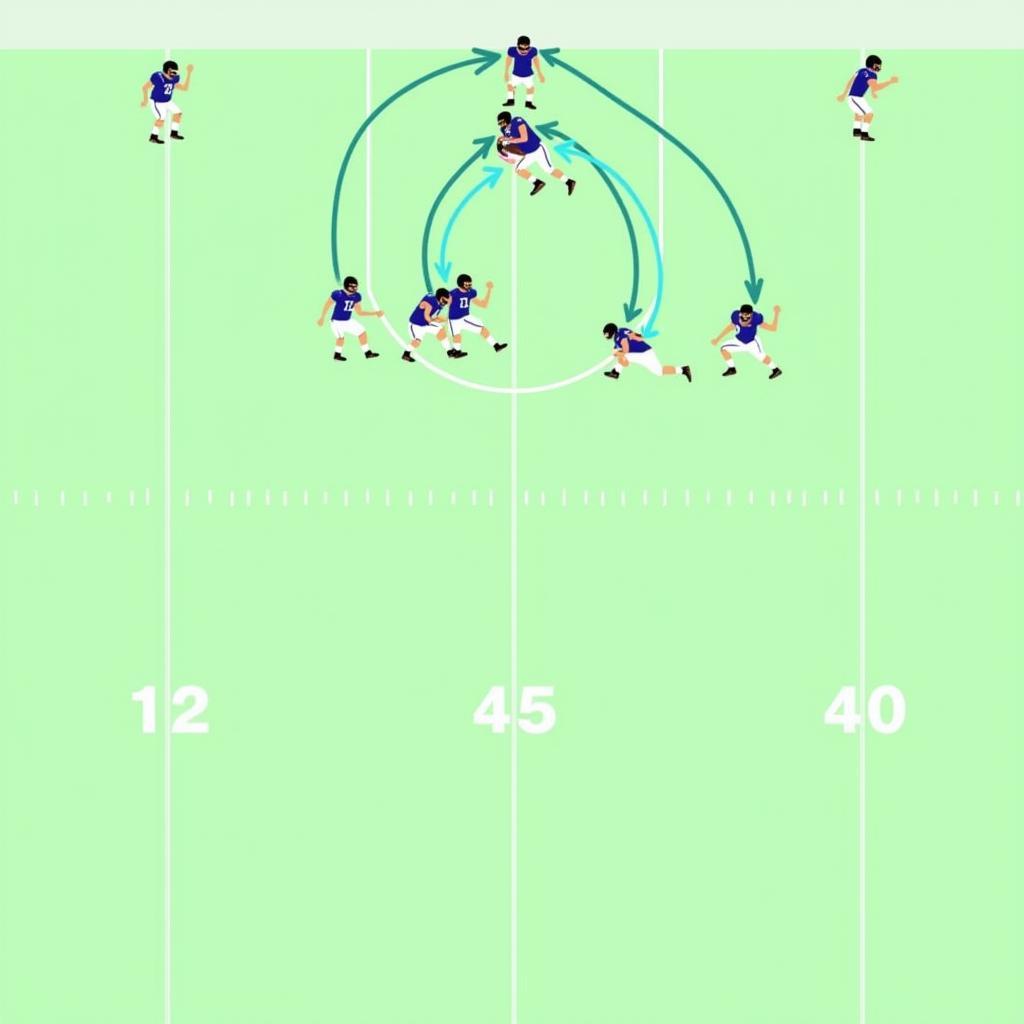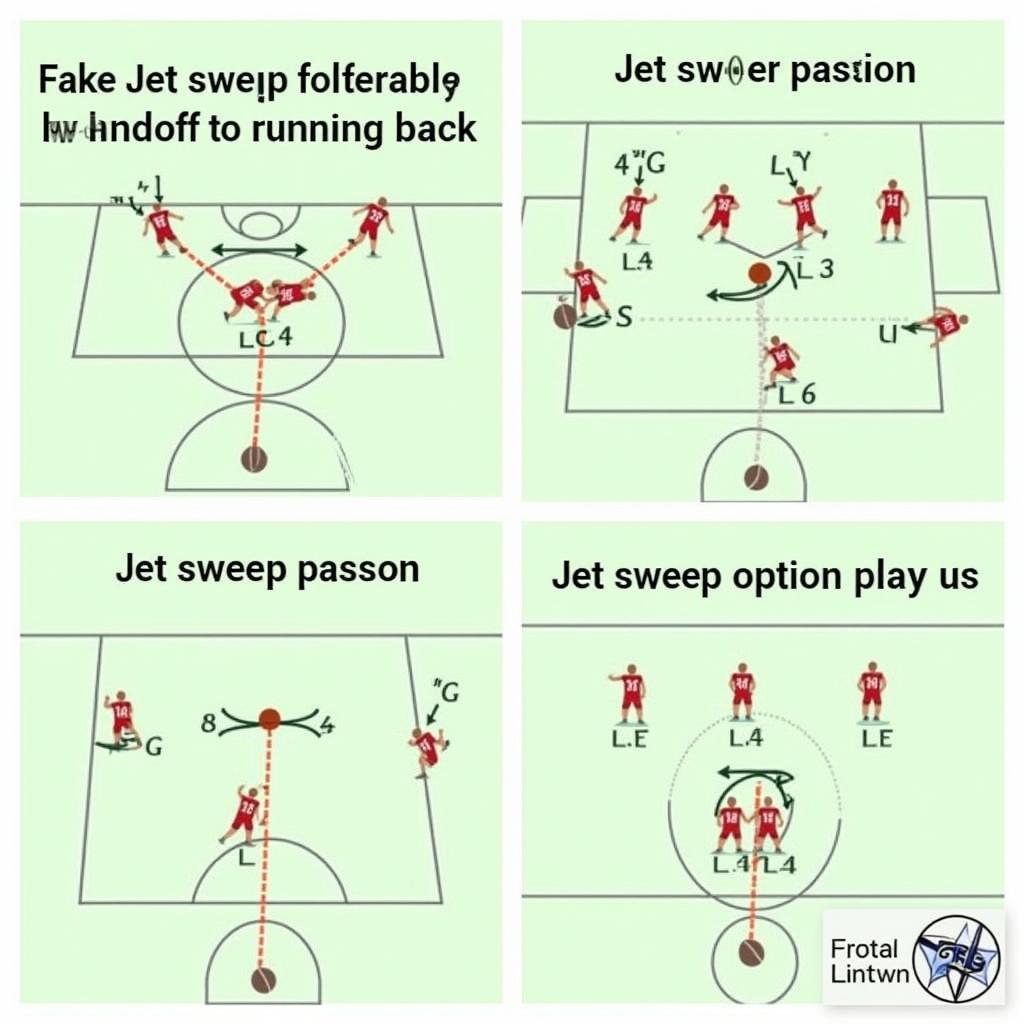The Jet Sweep Formation is a dynamic offensive strategy in American football designed to create explosive plays by utilizing speed and misdirection. It involves a backfield motion where a player, typically a wide receiver or running back, sprints across the formation to receive a handoff or pitch. This action forces the defense to react quickly, often creating opportunities for big gains. Let’s delve into the intricacies of this exciting play.
 Diagram of the Jet Sweep Formation
Diagram of the Jet Sweep Formation
Understanding the Basics of the Jet Sweep
The jet sweep is more than just a simple handoff; it’s a carefully orchestrated play that relies on precise timing and execution. At its core, the play begins with a receiver, often referred to as the “jet” motion player, moving at high speed across the backfield. The quarterback then either hands the ball off or pitches it to the receiver as they cross. This quick lateral movement creates confusion for the defense, forcing them to account for a potential runner coming from an unexpected angle. The element of surprise is crucial for the success of the jet sweep.
Key Players in the Jet Sweep Formation
The success of the jet sweep hinges on the performance of several key players. The quarterback’s timing and accuracy in delivering the ball are crucial. The receiver, of course, needs to have blazing speed and agility to exploit the gap created by the defense. The offensive line also plays a critical role in sealing off defenders and creating a clear path for the jet sweep runner. Even other backs and receivers can be crucial by running their routes effectively, drawing the defense’s attention, and further enhancing the misdirection.
Advantages and Disadvantages of the Jet Sweep
Like any offensive play, the jet sweep has both strengths and weaknesses. One of its primary advantages is its ability to stretch the defense horizontally, creating opportunities for big plays on the outside. It also forces the defense to be disciplined in their assignments, as over-pursuing can leave gaping holes. However, the jet sweep can be vulnerable to tackles for loss if the defense diagnoses the play quickly. It also requires precise timing and execution, making it susceptible to fumbles or botched handoffs.
 Variations of the Jet Sweep
Variations of the Jet Sweep
Why is the Jet Sweep Effective?
The jet sweep’s effectiveness stems from the speed and misdirection it employs. This creates stress on the defense’s perimeter players, who are forced to react quickly to a fast-moving threat. It’s particularly useful against defenses that tend to over-pursue or are vulnerable to outside runs. By forcing the defense to account for a horizontal threat, the jet sweep can open up opportunities for other plays later in the game, keeping the defense guessing.
Coaching the Jet Sweep: Tips and Strategies
Coaching the jet sweep requires attention to detail and consistent practice. Emphasis should be placed on the quarterback’s footwork and handoff/pitch technique, as well as the receiver’s timing and ball security. Coaches also need to develop variations of the jet sweep to keep defenses off balance, such as incorporating play-action passing or using different personnel groupings. Regularly reviewing game film can provide valuable insights into the defense’s tendencies, allowing coaches to tailor their jet sweep strategy accordingly.
“The jet sweep is like a chess match,” says Coach John Smith, a veteran high school football coach with over 20 years of experience. “You’re constantly trying to anticipate the defense’s moves and counter them with your own. It’s a game of deception and speed, and when executed properly, it can be a real game-changer.”
Conclusion: Unleashing the Power of the Jet Sweep
The jet sweep formation, when implemented effectively, can add a dynamic element to any offense. Its blend of speed and deception makes it a potent weapon against even the most disciplined defenses. By understanding the nuances of the play, coaching it meticulously, and adapting it to different game situations, teams can unleash the full potential of the jet sweep and create explosive plays on the field. Mastering the jet sweep is not just about running fast; it’s about executing a well-coordinated attack that keeps defenses on their heels.
“The key to the jet sweep is not just speed, but controlled speed,” adds Coach Sarah Lee, a renowned offensive strategist. “The receiver needs to be able to accelerate quickly but also maintain balance and control while receiving the ball and making their cut upfield.”
FAQ
- What is the main purpose of the jet sweep? To create quick, explosive plays by utilizing speed and misdirection.
- Who typically runs the jet sweep? A wide receiver or running back.
- What are the key elements of a successful jet sweep? Precise timing, accurate handoff/pitch, receiver speed, and offensive line blocking.
- What are some disadvantages of the jet sweep? Vulnerability to tackles for loss if the defense reads the play, and the risk of fumbles.
- How can coaches improve their team’s jet sweep execution? Focus on footwork, handoff/pitch technique, timing, ball security, and developing variations of the play.
Need assistance? Contact us 24/7: Phone: 0902476650, Email: [email protected] or visit us at 139 Đ. Võ Văn Kiệt, Hoà Long, Bà Rịa, Bà Rịa – Vũng Tàu, Việt Nam.





